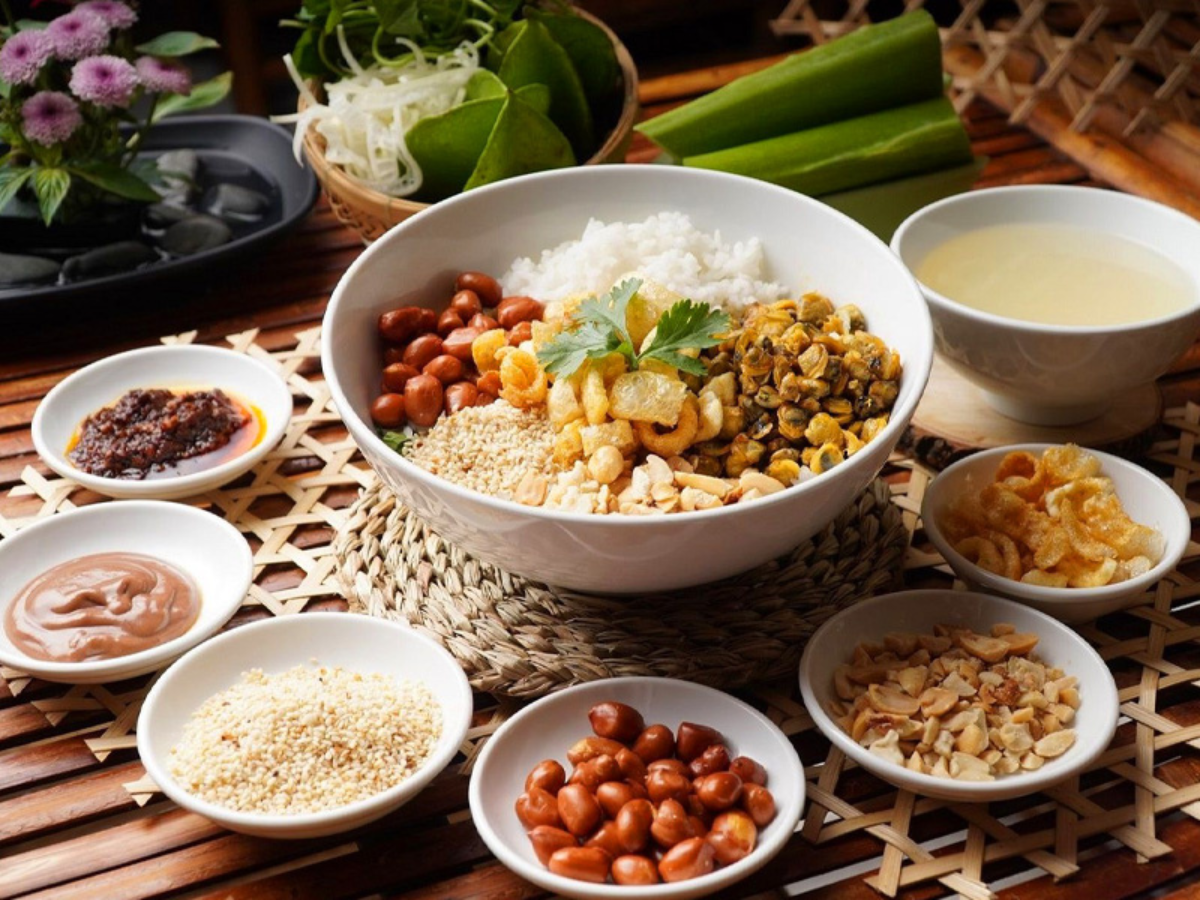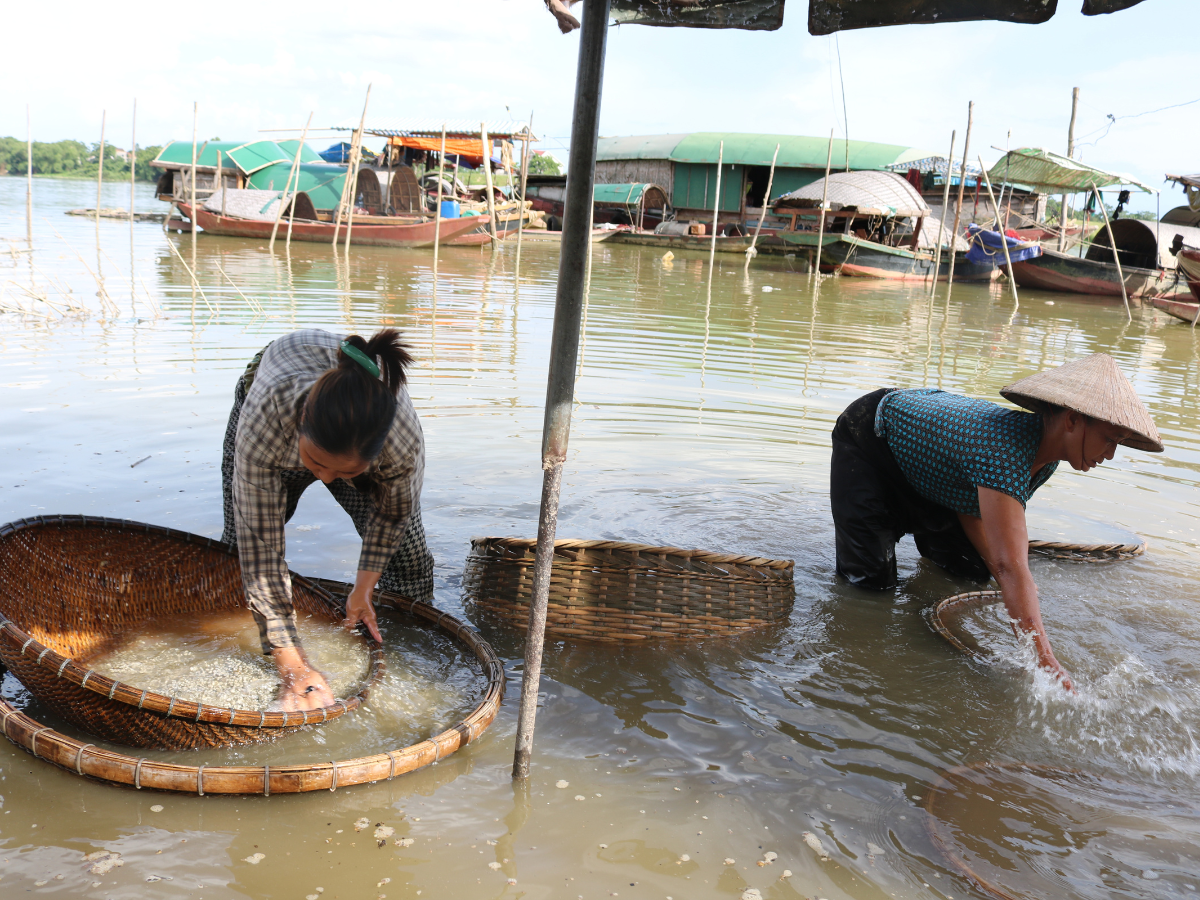1. What are Giang Village Clams? Origin, geographical location, and history of the craft village
1.1. Giang Village Clams and the land of Giang village
Giang Village Clams are a long-standing famous specialty of Giang village, located in Ham Rong ward, Thanh Hoa province. This place lies beside the gentle Ma River, in the section flowing through the alluvial-rich downstream area, creating a favorable environment for aquatic species to develop, especially Giang clams, a species of small clam with thin shells, sweet and naturally fragrant meat.

Giang Village is located by the gentle Ma River, creating a favorable environment for aquatic species to develop. (Source: Collected)
The name “Giang Village” is associated with an ancient địa danh (place name) with a history of hundreds of years, once a prosperous residential area for riverine dwellers. The people here have been attached to the profession of processing clams on the Ma River for generations, considering it a livelihood and a characteristic culture of the region. Thanks to the clean water, rich in silt and plankton, Giang Thanh Hoa clams have a special flavor, both deeply sweet and rich, unmatched by few other places.
Today, Giang clams are not only a rustic dish in Thanh region meals but have also become a famous specialty of Thanh Hoa city, sought after by many tourists to buy and enjoy in dishes such as stir-fried clams, clam porridge, clam noodles, and sour clam soup.
1.2. History of the formation and development of the clam processing profession
According to the elders in the village, the clam processing profession in Giang has existed for hundreds of years, formed along with the settlement of Thanh region residents along the river. Due to its location in the lower reaches of the Ma River, where the riverbed is gentle, the alluvial banks are wide, and there are many fine sandbanks, clams here reproduce naturally year-round.
In the past, people in Giang Village mainly processed clams manually using rakes, baskets, or iron nets, then brought them back to process for meat to sell at Tay Thanh market, Dau Thanh market, or surrounding areas. The bustling sound of clam raking every morning, along with the image of sampan boats drifting on the Ma River, has become a familiar symbol of the craft village.
Over time, although the clam processing profession is no longer as booming as before, it is still maintained by many households. Local people still consider Giang clams as “gifts from heaven,” a source of income that has been associated with generations. This specialty also contributes to creating the unique culinary identity of Thanh Hoa, mentioned alongside other famous dishes such as sour spring rolls, Ha Yen fermented shrimp paste, or shrimp paste rolls.
2. Process of harvesting, processing, and cooking Giang village clams
2.1. Traditional clam harvesting methods on the Ma River
When it was still dawn, people in Giang Village were bustling to the Ma River bank to start a new day of labor. The clam harvesting work still retains its traditional essence from generations past: using only sampans, bamboo baskets, and manual iron rakes or nets. People often choose areas with clear water, fine sandy bottoms, and gentle currents, where clams reproduce abundantly, have sweet meat, and are free from mud.
What makes the special quality of Giang village clams is the technique of choosing the right time and location for clam raking. Experienced people look at the water color, clarity, and silt deposition to identify “good clam beds.” After harvesting, the clams are washed clean immediately at the riverbank to remove impurities, preserving their natural sweetness and characteristic aroma. The entire process is done manually, helping the clams retain their freshness, without any muddy smell, creating the unique specialty brand of this region.
2.2. Clam processing and cooking stages in Giang village
The processing of Giang village clams is the crystallization of experience and the dexterity of local people. After harvesting, the clams are soaked in clean water for a few hours to expel sand, then boiled in a large pot for just enough time for the clams to open their shells while retaining their tenderness and sweet meat.
The stage of separating the shells to get the meat is the most important step, requiring meticulousness and quick hands. Workers use bamboo sieves or fine nets to process the clams under a gentle stream of water, shaking and filtering to leave only the ivory-white meat, free of shell fragments. The clam meat is then washed thoroughly several times, drained, and can be cooked immediately or refrigerated to maintain its freshness.

Giang Village Clams have tender, sweet, and delicately fragrant meat. (Source: Collected)
Thanks to the meticulous processing, Giang Village Clams have tender, sweet, and delicately fragrant meat characteristic of the Ma River. These are also the ingredients for a series of delicious Thanh Hoa region dishes such as stir-fried clams with dried onions, clam porridge, clam noodles, or sour clam soup, simple yet flavorful home-style dishes.
2.3. Production volume, economic value, and price of finished clams in 2025
Currently, in Ham Rong ward, dozens of households still engage in the clam processing profession, especially vibrant in summer when clams grow rapidly. On average, the village can harvest 1 to 2 tons of fresh clams daily, supplying the central Thanh Hoa market and surrounding areas.
The price of Giang Village Clams per kg of shelled clam meat is higher than clams in many other localities. Thanks to this, each household engaged in the profession can have a stable income, contributing to local economic development.
Not only bringing economic value, the profession of processing Giang Village Clams is also a symbol of traditional culture, demonstrating the bond between the people of Thanh Hoa and the Ma River, contributing to preserving the unique culinary identity of the Thanh Hoa region.
3. Nutritional value of Giang Village Clams
3.1. Outstanding nutritional components in clams
Hidden behind the sweet and characteristic aroma of Giang Village Clams is a precious source of nutrients bestowed by the Ma River's nature. According to food research, clam meat contains protein comparable to many red meats but is more easily absorbed and lower in fat. Especially, clams have a high iron content, helping to supplement essential nutrients for people with anemia or weakened bodies.
Besides protein and iron, Giang Village Clams also contain many important vitamins and minerals, making clams a healthy food suitable for many age groups. Thanks to being harvested from the clean, silt-rich waters of the Ma River, Giang Village Clams always retain their natural sweetness, deliciousness, and nutritional value.
3.2. Health benefits of eating clams
Regularly consuming clams in meals brings many health benefits. High-quality protein content helps the body recover, boosts immunity, and supports muscle development. For pregnant women, clams are a rich natural source of iron, helping to prevent anemia and supplement nutrients for fetal development.

Using clams in meals brings many health benefits. (Source: Collected)
Clam meat also contains omega 3 which helps enhance memory and protect cardiovascular health, while B vitamins support nervous system function. Due to its low calorie content but rich in nutrients, Lang Giang clams are very suitable for people on a diet or wanting to control their weight. This is a food that is both delicious and good for health, suitable for all family members.
3.3. Notes when enjoying clams
Although Lang Giang clams offer many nutritional values, not everyone is suitable for consumption. People with allergies to shellfish or weak digestive systems should try a small amount first to avoid reactions such as itching, indigestion, or mild stomach pain.
When preparing, it is necessary to wash thoroughly and cook thoroughly to remove sand, impurities, and limit the risk of parasitic infections in freshwater environments. Consumers should choose fresh clams, with an ivory color, a natural aroma, not fishy, and buy from reputable establishments in Thanh Hoa. Ensuring the origin and proper storage methods helps preserve the specialty flavor and ensure health safety.
4. Suggestions for combining with Thanh Hoa tourism
The journey to discover Lang Giang clams will be more complete when tourists combine visits to the prominent destinations of Thanh Hoa. In Ham Rong ward, tourists can learn about the traditional clam harvesting and processing process, listen to stories of the long-standing craft village, or directly participate in clam raking with the local people. After the experience, don't forget to enjoy the delicious dishes made from Lang Giang clams such as clam porridge, stir-fried clams with perilla leaves, or sour clam soup, these rustic flavors but rich with the soul of Thanh Hoa countryside.

Visitors can join clam raking with local people. (Source: Collected)
Continuing the trip, visitors can move to Sun World Sam Son , a modern entertainment complex by the Sam Son beach. The vibrant space, numerous entertainment activities, and high-class services here bring a refreshing feeling after hours of exploring the craft village. The combination of traditional cultural experiences and modern resort entertainment creates a memorable tourist journey, suitable for all ages.
To make the exploration trip of Giang Village clams convenient, visitors should prepare light clothing, wear easy-to-move-in shoes, and a sun hat as most activities take place outdoors. Giang Village is not far from the center of Thanh Hoa city, and can be easily reached by motorbike, car, or taxi.
Giang Village clams are not only a famous specialty but also an age-old cultural symbol, deeply associated with the lives of the people of Thanh Hoa. From the fresh batches of clams raked up by the Ma River to the skillful hands of the clam processors, all create a traditional beauty that is hard to find anywhere else. Each rich flavor not only evokes homeland memories but also contributes to preserving and spreading the cultural values of Thanh Hoa to visitors from near and far.



